#this post is in the queue but i am not
Text
DEVASTATING the lyric you've been mishearing is better than the real one
#i've been listening to icarus by bastille#and for some reason my brain fills in 'this is how it feels to take a fall' as 'this is how it feels to take off all your skin'#and like fuck man#and I KNOW that’s technically not a misheard lyric but my post my rules cope#anyway my line now#also probably phrased this poorly but its ok#im allowed to be incomprehensible#as a treat#and then fuckin#from we sink by of monsters and men#the original line was 'please look away dont look at me'#and i kept hearing it as 'please learn a way to look at me'#anyway#shoving this post in the queue but please be aware that i am writing it very late at night#q
73K notes
·
View notes
Text
fun fact: @staff recently made a cute little change to desktop where clicking on the url of the previous reblog will now take you to the top of that person's blog, instead of their reblog of the post

a super cool fun consequence of this is that it is now way harder to find previous tags! so if you're gonna 'prev tags' someone, I highly recommend also copying their tags into your reblog. (It's generally a good thing to do anyway tbh, in case the previous reblog ever gets deleted and their tags are lost forever.)
I will definitely be sending my feedback in a support ticket, and if this pisses anyone else off, I suggest that you do the same!
Update: Putting this post in reblog jail. I think my explanation of the issue wasn't clear enough and don't want it to spread and cause more confusion
#this change is completely fucking with the way i queue the carmilla series daily posts so that's been real great :) /s#staff I am in your walls
13K notes
·
View notes
Text

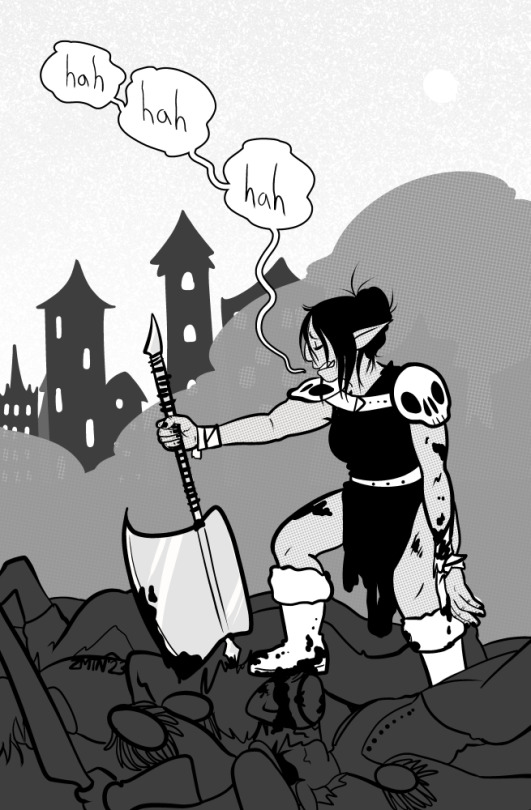




[Full comic transcript under cut in addition to the alt text.]
So I've been working on a short comic, and here's a preview of the first five pages and the cover. They still need some cleanup and editing, and the rest of the pages of course, but I hope you enjoy them!
Images:
First is a cover, in greens, oranges and purples. Title: The Orc and Her Bride, A Comic by Zoe Maxine. The illustration shows a surprised orc woman in a fancy cape and circlet holding an equally surprised dark skinned elf woman in a creamy bridal dress and crown.
Page 1. Full page drawing of the orc woman, looking far more ramshackle, covered in blood on a pile of bodies, and holding a giant axe. She pants with exhaustion.
Page 2. She looks over to see three people murmuring around a nearby building.
Orc: "Don't tell me there's more."
The three pointy eared people approach, looking frightened.
Bearded man with his hands raised: "Mistress - Please, have mercy."
The Orc is shocked, before she looks down, muttering, "Not looking forward to this part."
Looking at the bearded fellow she says, "I will not harm the unarmed."
Sighing, the bearded man says, "Thank you, Mistress."
Avoiding his eyes, the orc says, "I don't deserve your thanks. I have killed many of your brethren."
Page 3. Two of the people exchange a look between them, faces neutral.
Bearded one: "…Our soldiers, yes."
The other, an older woman with short hair, looks at the orc. "Mistress, where do you come from?"
Bearded one: "Why have you done this?"
A shadow passes over the orc's face. "I am from Eskerfort."
The next panel shows her saying "And… because I am from Eskerfort." over a flashback to her kneeling on the ground, defeated, in front of burning houses with soldiers barely visible in the background.
The two people in the present look away, almost ashamed, saying "Ah," with understanding.
Page 4. Looking down at the bodies below her, the orc says, "I am tired of bloodshed. I have avenged my kin. I will darken your doorways no more and leave you in peace."
As she turns to leave, however, the beareded one rushes forward. "Wait! Worrier! Stop! Please!"
The elfin woman looks up at her, asking, "Do you not know our laws?"
Together the two try to point out something to the orc. "Look, please!" "Look!"
Among the bodies is a fancily dressed one wearing a circlet.
Off-panel, the people say, "That one you killed among the dead - he was our king."
One of them reaches down to grab the circlet.
Page 5: Looking concerned, the orc woman says, "Are you asking me to be executed? For Regicide?"
As the elfin woman is doing something, the bearded one puts his hands on his hips and looks up sternly. "No, Warrior, we are asking you to take responsibility."
The elfin woman holds the circlet up to the orc. It shines. "Our laws are clear," she says, "Whoever kills the king becomes the new king."
The orc stares ahead, eyes becoming pinpricks. "What?"
The next panel has her dressed in a fur lined cape with the circlet on her head, her hair being brushed. She has the exact same expression on her face. "what?"
The last panel has her sitting at the head of a long table with all the elfin people enjoying themselves around her. "what"
4K notes
·
View notes
Text

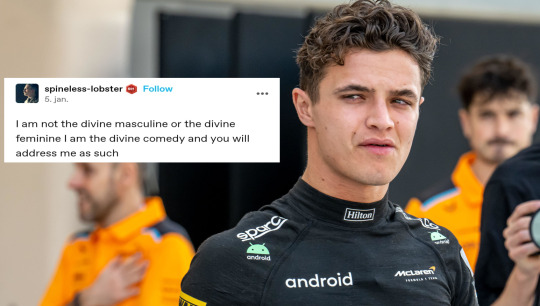
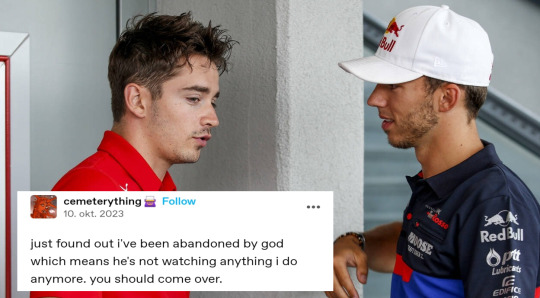

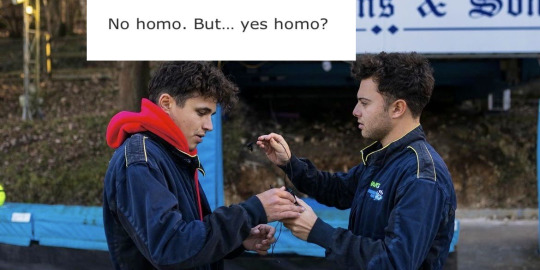



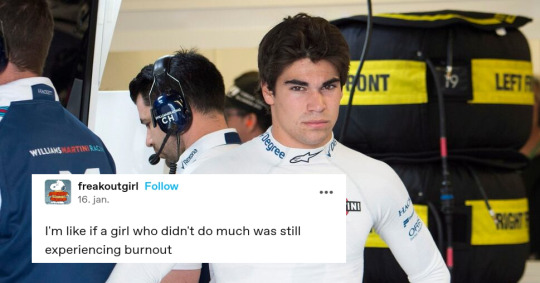
f1 + txt posts = true 2.0
#once again lance is catching strays but what can i say#his face is annoying to me#also ignore the fact that pierres eyes are blue not brown#this one im actually going to queue so i am actually trying not to spam#txt posts#lando norris#charles leclerc#pierre gasly#lewis hamilton#nico rosberg#sebastian vettel#brocedes#piarles#formula 1#f1#f1 + text posts#i wont tag lance cause im nice#max fewtrell#my txt posts
1K notes
·
View notes
Text
girls will see the word library in a post and hit reblog
#tis me... girls am i....#this post will make more sense when the library related post i put in my queue actually pops up#anyways. the number of days i go to the library in a week are rapidly inclining again...and it's never lower than 1 i can say that much....#library tag
3K notes
·
View notes
Text
Things to Do that Aren't Related to Growing Plants
This is my second post in a series I’ll be making on how to increase biodiversity on a budget! I’m not an expert--just an enthusiast--but I hope something you find here helps!
Some of us just don’t have much luck when it comes to growing plants. Some of us simply want to aim for other ways to help that don’t involve putting on gardening gloves. Maybe you've already got a garden, but you want to do more. No problem! There’s a couple of options you can look into that’ll help attract wildlife in your area without even having to bring out any shovels!
Provide a Water Source
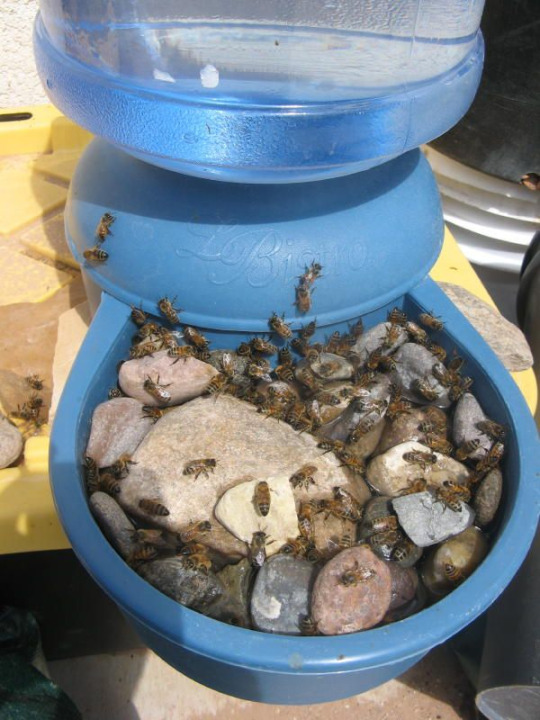
Oftentimes when I see ‘add a water source’ in informational articles about improving your backyard for wildlife, it’s almost always followed by an image of a gorgeous backyard pond with a waterfall and rock lining that looks expensive to set up, difficult to maintain, and overall just… not feasible for me. Arguably, not feasible for a lot of people. And that’s okay! There’s still ways to add water in your garden for all kinds of creatures to enjoy!
There’s tons of ways to create watering stations for insects like bees and butterflies. A self refilling dog bowl can work wonders! Add some stones into the receiving tray for insects to land on or use to climb out, and you’ve got a wonderful drinking spot for all kinds of insects! You can also fill a saucer or other dish with small stones and fill it, though it’ll likely need refilling daily or even several times a day during hot times.
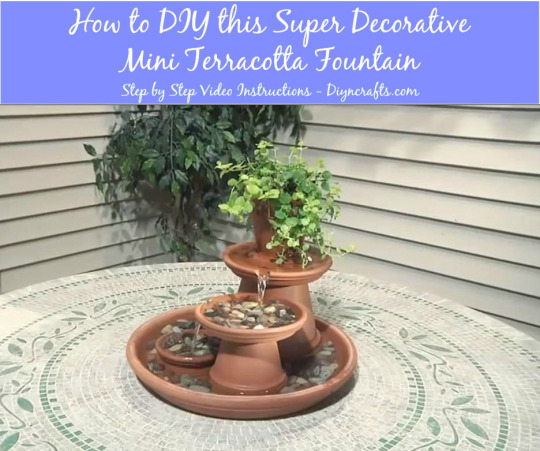
I've seen people online use all kinds of things to make water features. Some go with terra-cotta pots, pebbles, and a cheap pump to get a small and simple fountain. Others use old tires, clay, and a hole in the ground to create an in-ground mini pond system. If all else fails, even a bucket or watertight box with a few plants in it can do the trick--though do be wary of mosquitoes if the water isn’t moving. In situations like these, a solar-powered fountain pump or bubbler are great for keeping the water moving while still making it a drinking option for wildlife (it not even more appealing for some)--and these items can be obtained fairly cheap online!
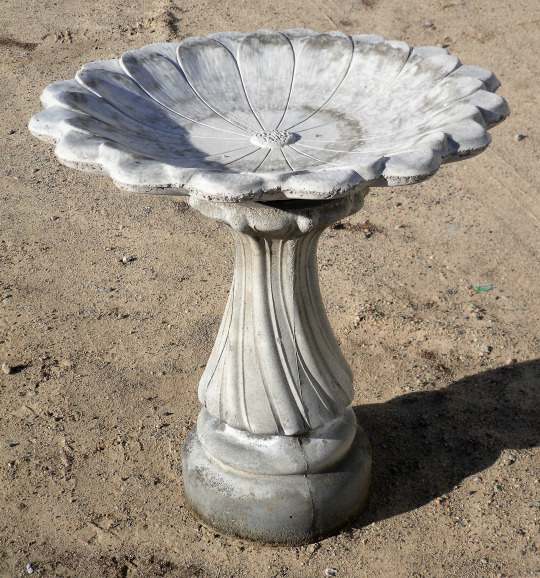
Bird baths are an option as well--a classic way to provide for birds in your area, they can be easy to find online or in a gardening store! The only downside is that a good, quality bird bath can be pricey up-front. However, a nice stone bird bath should last a long time, be easy to clean and refill, and be enjoyed by many birds! I’ve also seen tutorials on how to make your own with quickcrete! Bird baths will be a welcome sight to birds, as they provide a space for them to drink and bathe to regulate the oils in their feathers for flight and insulation. Putting a stone in the middle will also help insects to escape if they fall in, and provide a place to perch so they can get their own drink. You’ll want to change the water and clean the baths regularly--as often as once a week, if you can manage it.
If possible, it’s highly encouraged to fill and refill water features with rainwater instead of tap water. Tap water is often treated, so instead of using hoses or indoor kitchen water, collecting some rainwater is a great alternative. Collecting rainwater can be as simple as leaving cups, bins, or pots outside for awhile.
Butterflies and other creatures will also drink from mud puddles. If you can maintain an area of damp soil mixed with a small amount of salt or wood ash, this can be fantastic for them! Some plants also excel at storing water within their leaves and flowers (bromeliads come to mind), making them an excellent habitat for amphibians as well as a drinking spot for insects and birds.
Bird Feeders and Bird Houses

Some of the fancy, decorated bird feeders are expensive, but others can be pretty low-cost--I got my bird feeder from Lowe’s for around 10 dollars, and a big bag of birdseed was around another 10 dollars and has lasted several refills! If you don’t mind occasionally buying more birdseed, a single birdfeeder can do a lot to attract and support local birds! If you’re handy, have some spare wood, and have or can borrow some tools, you may even be able to find instructions online to make your own feeder. You may not even need wood to do so! Even hummingbird feeders, I’ve found, are quick to attract them, as long as you keep them stocked up on fresh sugar water in the spring and summer!
An important note with bird feeders is that you have to make sure you can clean them regularly. Otherwise, they may become a vector for disease, and we want to avoid causing harm whenever possible. Also keep an ear out and track if there’s known outbreaks of bird diseases in your area. If local birding societies and scientists are advising you take your birdfeeders down for awhile, by all means, do it!

Bird houses are naturally paired with bird feeders as biodiversity promoters for backyard spaces, and it makes sense. Having bird houses suited to birds in your area promotes them to breed, raise their young, disperse seeds, and generally engage in your surrounding environment. Setting them up takes careful selection or construction, preparation, and some patience, but sooner or later you might get some little homemakers! Keep in mind, you will need to clean your birdhouses at least once a year (if not once per brood) to make sure they’re ready and safe for birds year after year--you wouldn’t want to promote disease and parasites, after all. But they could be a valuable option for your landscape, whether you purchase one or construct your own!
Again, do make sure you're putting up the right kind of boxes for the right kinds of birds. Bluebird boxes are some I see sold most commonly, but in my area I believe they're not even all that common--a nesting box for cardinals or chickadees would be far more likely to see success here! And some birds don't even nest in boxes--robins and some other birds are more likely to use a nesting shelf, instead! Research what birds live in your area, take note of any you see around already, and pick a few target species to make homes for!
Solitary Bee Houses

A bee house or bee hotel is a fantastic way to support the solitary bees in your area! For a few dollars and some annual cleaning, you can buy a solitary bee house from most big box nurseries. Alternatively, you can make one at home, with an array of materials you may already have lying around! You can even make them so that they’ll benefit all kinds of insects, and not necessarily just bees.
Though you don’t even necessarily have to break out the hammer and nails, buy a ton of bricks, or borrow a staple gun. Making homes for tunneling bees can be as simple as drilling holes in a log and erecting it, or drilling holes in stumps and dead trees on your property. You might even attract some woodpeckers by doing this!
Providing Nesting Area
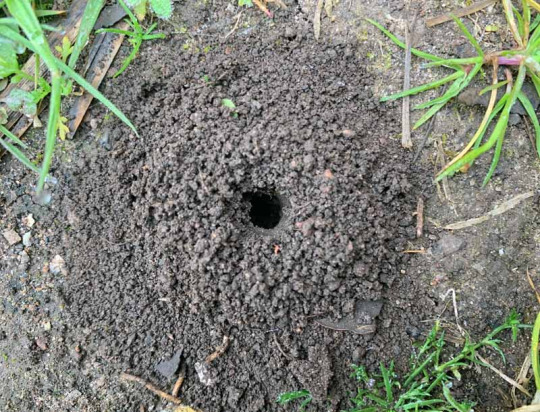
There are tons of different kinds of bees, and they all make different kinds of homes for themselves. Not all of them make big cavity hives like honey bees, or will utilize a solitary bee house. Bumblebees live in social hives underground, particularly in abandoned holes made by rodents--some others nest in abandoned bird nests, or cavities like hollow logs, spaces between rocks, compost piles, or unoccupied birdhouses. Borer, Ground, and Miner bees dig into bare, dry soil to create their nests. Sparsely-vegetated patches of soil in well-drained areas are great places to find them making their nests, so providing a similar habitat somewhere in the garden can encourage them to come! I do talk later in this document about mulching bare soil in a garden--however, leaving soil in sunny areas and south-facing slopes bare provides optimal ground nesting habitat. Some species prefer to nest at the base of plants, or loose sandy soil, or smooth-packed and flat bare ground. They’ve also been known to take advantage of soil piles, knocked over tree roots, wheel ruts in farm roads, baseball diamonds and golf course sand traps. You can create nesting ground by digging ditches or creating nesting mounds in well-drained, open, sunny areas with sandy or silty soil. However, artificially constructed ground nests may only have limited success.
Providing Alternative Pollinator Foods
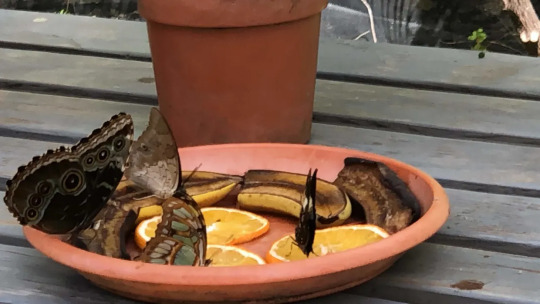
Nectar and pollen aren’t the only foods sought out by some pollinators! Some species of butterflies are known to flock to overripe fruit or honey water, so setting these out can be an excellent way to provide food to wildlife. You may want to be cautious about how you set these out, otherwise it can help other wildlife, like ants or raccoons. Butterflies may also drop by to visit a sponge in a dish of lightly salted water.
Bat Houses and Boxes
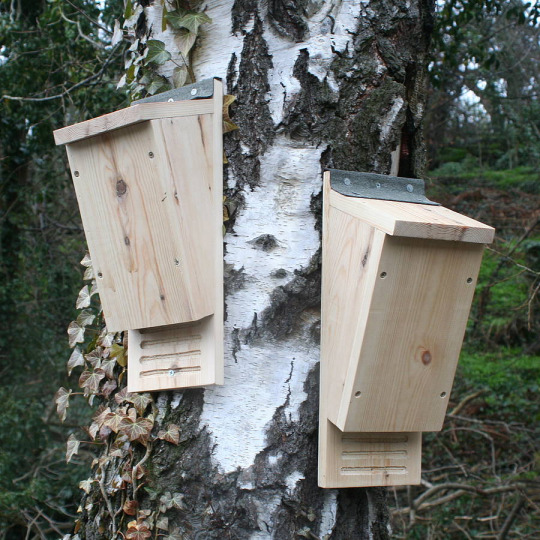
Big or small, whether they support five bats or five hundred, making bat boxes and supporting local bats is a great way to boost biodiversity! Not only will they eat mosquitoes and other pest species, but you may also be able to use the guano (bat droppings) as fertilizer! Do be careful if you choose to do that though--I’ve never had the opportunity to, so do some research into how strong it is and use it accordingly.
Provide Passageway Points
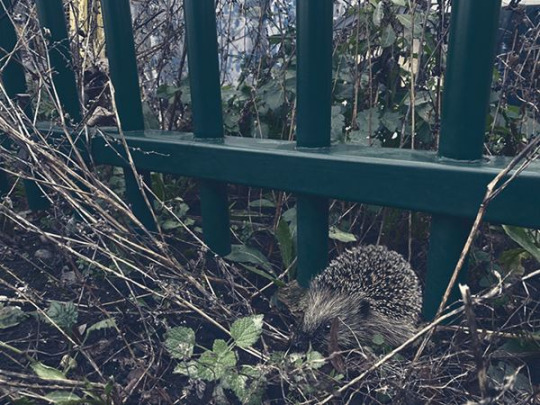
If you want your area to be more accessible for creatures that can’t fly or climb fences, allowing or creating access points can be an excellent way to give them a way in and out. Holes in the bottom of walls or fences can be sheltered with plants to allow animals through.
In a somewhat similar manner, if you’re adding a water fixture, it’s important to provide animals a way to get into and out of the pond--no way in, and they can’t use the water. No way out, and they may drown. Creating a naturalistic ramp out of wood beams or sticks, or stepped platforms out of bricks, stones, or logs can do the trick.
Get or Keep Logs and Brush Piles

I’ve already mentioned logs a good handful of times so far in this post. To be used as access ramps, or as nesting areas for solitary bees. But they have value as much more than that! Logs on the ground provide shelter for all kinds of animals, especially depending on size--anything from mice, reptiles, and amphibians to things like turkey vultures and bears will use fallen logs as shelter. Inside of a decaying log, there’s a lot of humidity, so amphibians are big fans of them--meanwhile, the upper sides of them can be used as sunning platforms by things like lizards. Other animals can also use the insides of logs as nest sites and hiding places from predators too big to fit inside. Fungi, spiders, beetles, termites, ants, grubs, worms, snails, slugs, and likely much more can be found inside rotting logs, using the rotting wood as food sources or nesting places. They can then provide food for mammals, amphibians, reptiles, and birds. They can also be regarded as a landmark or territory marker as wildlife get more familiar with your space.
So how do you get logs for cheap? Try Chip Drop! I talk about them more in a future post, but you can mark saying that you’d like logs in your drop, so they’ll give you any they have! In fact, you may even get a drop faster if you're willing to accept some logs. You may also be able to approach arborists you see working in your area and ask for logs. There may also be local online listings for people selling logs for cheap, or just trying to get rid of them. If there’s land development going on near you, you may be able to snag logs from trees they cut down to make space. Do keep in mind, you don’t need to have huge gigantic logs laying around your property to make an impact--even small logs can help a lot.

If possible, creating and leaving brush piles on the edge of your property can be a great boost to biodiversity--even if you may not see the wildlife using it. They’ll provide shelter from weather and predators, and lower portions are cool and shady for creatures to avoid the hot sun. The upper layers can be used as perch sites and nest sites for song birds, while lower layers are resting sites for amphibians and reptiles, and escape sites for many mammals. As the material decays, they also attract insects, and as such they’ll attract insect-eating animals too. As more small animals find refuse in your brush pile, their predators will be attracted to them as well. Owls, hawks, foxes, and coyotes are known to visit brush piles to hunt. Making a brush pile can be as simple as piling branches and leaves into a mound, as big or as small as you want. You can even use tree stumps or old fence posts near the base, and keep stacking on plant trimmings and fallen branches. Do note that you don’t want to do this near anything like a fire pit.
Don't forget, with all of these, your mileage may vary for any variation of reasons, so don't worry if you can't take all of even any of these actions! Even just talking about them with other people may inspire someone else to put out a bat box, or leave a few logs out for wildlife!
That's the end of this post! My next post is gonna be about ways to get seeds and plants as cheaply as possible. For now, I hope this advice helps! Feel free to reply with any questions, success stories, or anything you think I may have forgotten to add in!
#biodiversity#solarpunk#environmental stewardship#gardening#outdoor gardening#(i know this is literally the Dont Gotta Garden post but these could also be excellent additions to a preexisting garden so)#ani rambles#out of queue#the biodiversity saga#here in the tags to once again emphasize your mileage may vary with all of these#my mom is scared of bats theres no way in hell shes gonna let me put up a bat box#but I have been able to put out a shallow bird bath and a little solarpowered hummingbird bath fountain#do what you can! every bit counts! You may be able to do something that I or your neighbors can't!#for example my nextdoor neighbors have literally no trees in their backyard where the hell would they put a bat box#meanwhile i have trees in my backyard but still can't put up a bat box. maybe the neighbors next to me could!#similarly brush piles are a no go for my family but someone somewhere else could set one up!#i am rambling in the tags now uh long story short do what you can don't stress about what you can't
4K notes
·
View notes
Text




the hottest couple in got. Period.
#since y‘all went crazy as soon as i post a gif of them here you go#a treat for your eyes everyone#i am your cool slutty queue#pedro pascal#indira varma#myedit#jose pedro balmaceda pascal#got#game of thrones#oberyn martell#ellaria sand
2K notes
·
View notes
Text


transfiguration's gonna come for me at last, and i will burn brighter than the sun
#posting a little mello deathnote 5 mins before the end of his birthday. as a treat#its been a couple rough months catching up with the commission queue so#technically this is from september i just went through my sketchbook trying to find something that'd be easy to finish#him....... alex are you still hyperfixated on-- yes. yes i am. death note blorbos save me. death note blorbos please#death note#mihael keehl#mello#mello death note#mello dn#meronia#horreurart
959 notes
·
View notes
Text












You can't fight the role the Mother had in store for you
#Homestuck#Karkat Vantas#Eridan Ampora#Sollux Captor#Gamzee Makara#Kanaya Maryam#Aradia Megido#Tavros Nitram#Feferi Peixes#Terezi Pyrope#Vriska Serket#Equius Zahhak#Splickedydoodles#I started drawing Karkat last night at like nine PM and then I pretty much blacked out and woke up with these at eight AM#this style is VERY fun and relaxing to work in it turns out it's been a minute since I got in my flow that hard for a piece of art#keeping my shit fast and loose!!! painting all on one layer and going by the Vibes!!!#anyway here's these I might have to queue them to post later tonight too haha#I'm not good enough at delayed gratification to just wait till later when more people are on and I need to go to bed tbh
3K notes
·
View notes
Text

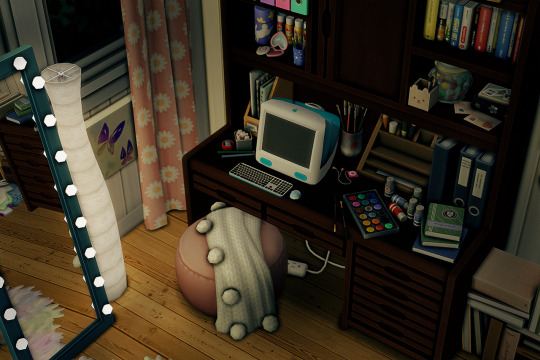
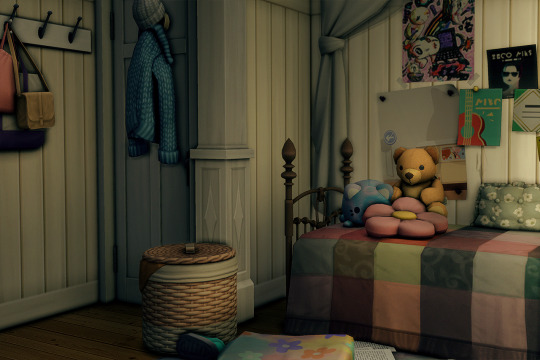
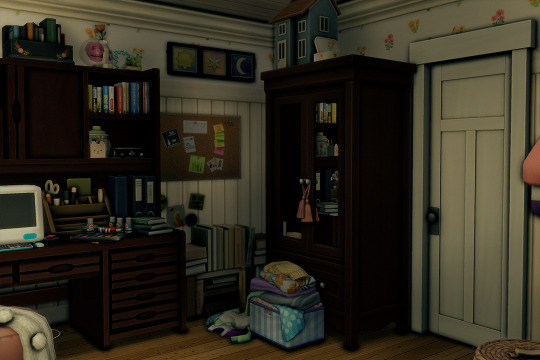
#ts4#the sims 4#ts4: build#man I really love making teen rooms#i always wanted those cool rooms teens had on tv/movies#the sims will have to do i guess u_u#also gg im posting this at 4 am this is my worst timing yet and no i won't queue it im a stubborn bitch lol
497 notes
·
View notes
Text
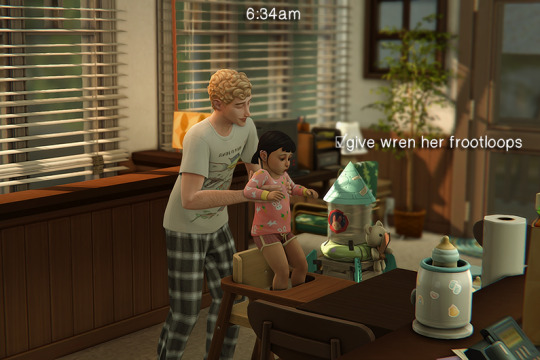

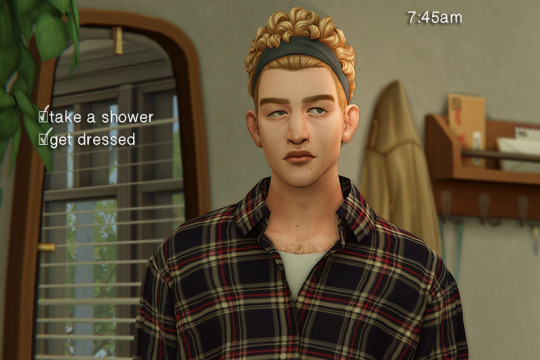

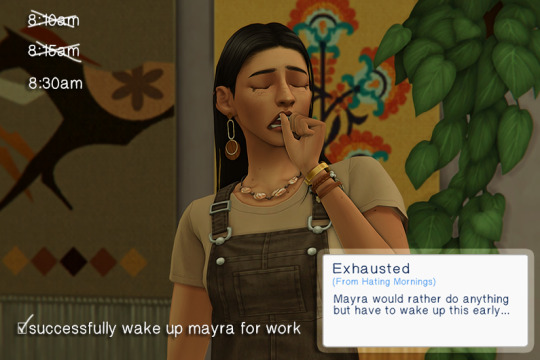

my for rent family's morning routine ✨
okay here's their backstory gyuhjfgk
jameson schaeffer and mayra villanueva are hs sweethearts who accidentally conceived their daughter wren during their junior year of college. it wasn't ideal timing but they made the best out of the situation and even finished uni. after bouncing from shitty apartment to shitty apartment they landed at a slightly less shitty apartment after the birth of their son andres, the birchview apartments! they're still trying their best to make ends meet but they're staying afloat.
jameson schaeffer - 23, good, bro, socially awkward
working as a night school teacher, jameson stays with the kids during the day and going to work at night. meaning, he's only staying awake due to many, many cups of coffee. he doesn't have much time for hobbies but falling asleep on the couch with a beer in his hand and the hockey game on is the closest it gets.
mayra villanueva - 24, nosy, creative, outgoing
born to run her etsy shop full-time, forced to work at target, mayra hates her job and hates mornings even more. soon as she's off the clock she's busy doing any creative venture she can. most notably, jewelry making and painting. she hopes to someday to be able to quit her retail job for good but that's not looking viable at the moment.
wren schaeffer - 3, wild
as a daddy's girl who's been spoiled rotten, wren has been kicked out of 3 pre-schools for various infractions (usually biting), so now she stays at home with dad during the day.
andres schaeffer - 18 months, calm
just a lil guy chillin. he doesn't even mind when wren tries to put him in a cardboard box and ship him away
#ts4#s#for rent gameplay#dont get too attached this is gonna be like 10 posts max fgkjgf. like the ending is already planned#i just needed something to do while chu huas queue caught up to where i am irl fgjkglf
635 notes
·
View notes
Text
thinking about painsluts with a dom that purposefully doesnt hurt them. instead, treats them with the utmost care, gently caressing their pretty face and murmuring out the sweetest praise. everytime they watch your hand raise they brace themselves for a familar slap that makes them lose their minds, but it never comes and they are left with tense muscles and a loss for words. it was nearly impossible to casually beg for someone to grant them their dirtiest desires, but you know exactly what they need, and just taunt them with it, because you want to hear their pathetic cry. and eventually after too many soft kisses and too many gently caresses, they let out the rawest noise, as if it just tumbled out of them against their will: "please hurt me.", "break me.", "ruin me."
gojo satoru, keigo tamaki, meguru bachira, douma, reo mikage
#mello.thirsts#🍀 - queue#i am too embarrassing to post this rn so future mello will have to deal with the consequences#also i see more ppl to be like this but these r my top top ppl if that makes sense#yuuta and sukuna both are teetering on that but i feel like they wouldnt necessarily ask for it they would just enjoy the soft touches
792 notes
·
View notes
Text






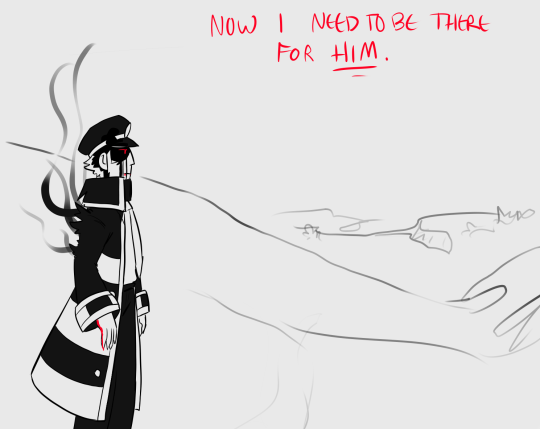
Part 3: 7
[first] [all]
[previous] [next]
a brief flashback, set very soon after the last one we saw :)
#submas#submas au#placeholder au#ingo#inky#emmet#blood#submas angst#pla era#i will not lie. i completely forgot to post this#just. utterly and completely. it vanished from my mind the second i saved it as a draft#and so. as i am adding the links (finally). i am going to queue it so i don't forget again lol
314 notes
·
View notes
Text
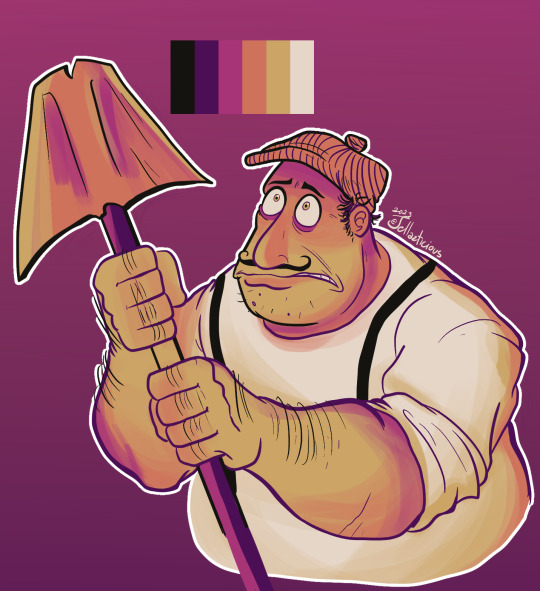



What's this?? Peppino drawn in my non cartoony style???
🍕 🍕 🍕 🍕
#Pizza Tower#Peppino Spaghetti#I drew this#*blows smoke off my pen* still got it#oh btw. I am setting the queue to one post a day. I am getting milked dry bsrjkgbjkgbrskjbr
480 notes
·
View notes
Text

the raw guy
#vinny vinesauce#vinesauce fanart#vinesauce#what if i told u i was very embarrassed to post this#rlly badly done low effort sketch studies of him bc fun fact my computer deleted the og file the other day so i just. redrew it all wihtout#caring too much the second time around BUT I WANTED TO DRAW HIM it was sooo fun still ddont know how to draw him too well but ill see.#need to watch more of his streams sorry guys im from jerma nation but i like red vox so thats why im crossing territory#queue are lovely#i added to ita flags bc its funny and also i am so used to putting a flag SOMEWHERE . my brain
1K notes
·
View notes
Text
Adding To or Starting a Garden
AKA, the beginning of the Plants-Related section of this series.
This is my third post in a series I’ll be making on how to increase biodiversity on a budget! I’m not an expert--just an enthusiast--but I hope something you find here helps!
Got an area of lawn you’d like to convert to a wildlife haven? An area you can stick some hanging baskets in? Want to know how your garden of tomatoes and zucchinis is already putting in a lot of work? This is the section for you!
It would be dumb of me to not acknowledge that the act of gardening can come with a lot of costs. Buying seeds, buying plants, buying soil, raised bed materials, mulch, etc. … it can all get a bit daunting, let’s be honest! But there’s quite a few ways to get seeds and plants for free or extremely cheap, which I’ll be addressing in this section! The next section will be all about addressing the other Costs in gardening and how to mitigate or eliminate them entirely.
Also, do keep in mind; there’s no need to try and convert a whole area from lawn to garden or unused to garden at once. In fact, it could actually be extremely beneficial to do it a little at a time--maybe four or five square feet to start out.
Front Lawn (or Managing Principles)
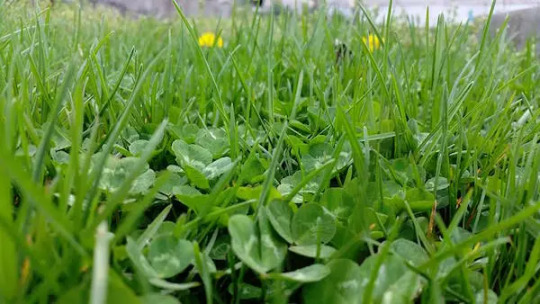
If you live in a place where you’re required to have a grass turf lawn (HOA’s come to mind…), try replacing it with native grasses instead! You could even possibly use a low-growing ground cover plant like clover to a similar effect! Reseeding/replacing an entire lawn can be a big upfront cost, but even just letting the lawn be a little messy and tall helps. If the lawn gets patchy, leave the bare spots for a little while and something different will likely pop up! Pioneer species will fill the gaps and provide benefits to other plants around them, support animals, and more! If you want to take the guesswork out of it, you could always research what the pioneer species are in your area and plant the ones you like most.
Obtaining Seeds for Cheap or Free
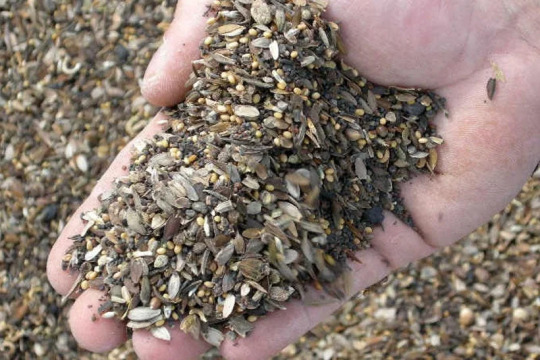
The cheapest way to start a garden is by far via seeds. However, seeds can be a bit complicated to grow, and some sources make them… way overpriced. Fortunately there are ways to get seeds for little to no cost!
Some places sell seeds for as low as a dollar, 50 cents, or 25 cents! The packets may not have a lot of seeds, but it’s definitely a good start for a low budget! I’ve personally bought cheap seed packets at Walmart--the Ferry-Morse and Burpee brands are not what we’re looking for here. Typically the cheaper ones I’ve found are American Seed (which is owned by Green Garden Products, which also owns Ferry-Morse, Livingston Seed, McKenzie Seed, and Seeds of Change. Do with that information what you will), but they’re rarely stocked near the Ferry-Morse ones in the Formal Gardening Section. I’ve most often found them on end caps near the gardening section, so you may have to weave through a few aisles to find them, but once you do there’s an array of flower and vegetable seeds to select from! Alternatively, I’ve found seeds at Dollar Tree sold 2 or 4 for a dollar in Spring as part of their seasonal product; however, when they’re out of stock, they’re typically out of stock for the year. Try to check them out early in the year!
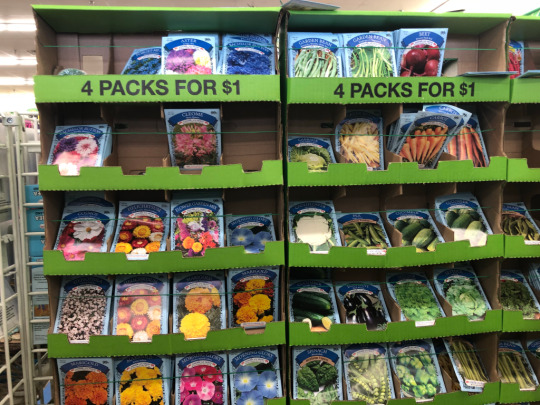
Otherwise, other seed companies like Urban Farmer or Botanical Interests will often have semi-frequent sales in spring and fall, when people are stocking up on seeds--joining their email lists can help you be the first to know when a good sale is going on!
Some foods from grocery stores will provide seeds that you can use in the garden as well. I’ve had the most luck with store-bought bagged beans, peppers, and tomatoes. Some people have had luck with watermelons, apples, citrus, squash, and more. Do keep in mind that you likely won’t get the same variety of fruit/vegetable as the one you bought--the resulting plant may look different and taste different.
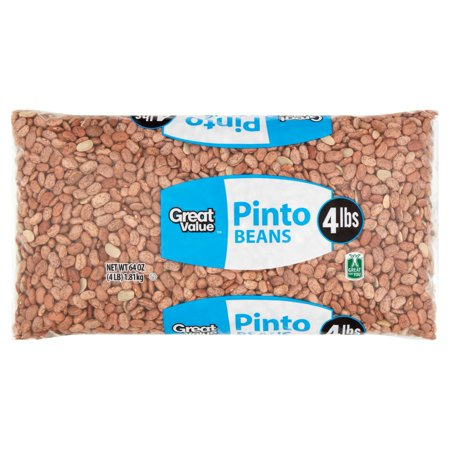
Give it a shot! Pick some beans you like--if they don't grow well, at least you can eat the rest!
If you live in the US, food-producing live plants, bare roots, and seeds can often be purchased with SNAP benefits. But what does growing fruits, veggies, and herbs have to do with boosting biodiversity? While food crops aren’t typically native, they still provide valuable shelter for native insects. Some plants even have intricate relationships with native fauna--like the squash bee, a solitary bee which exclusively pollinates cucurbits like pumpkins, squash, and zucchini. And we get to benefit more directly as well! If you’re planting a diverse range of foods in your garden (as opposed to the swaths of single-plant farms that typically produce what’s sent to grocery stores), you’re supporting high levels of biodiversity by providing a variety of plants for creatures to live and hunt around.
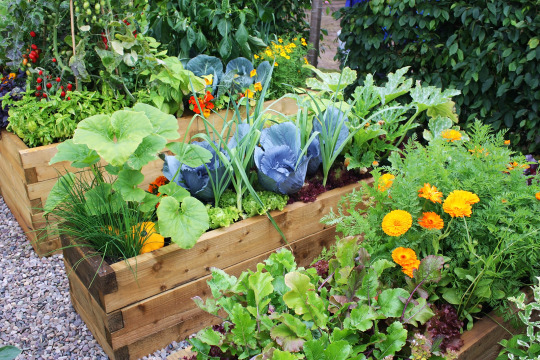
Most of the time, when we think of boosting biodiversity with a garden, we think of a colorful flower garden teeming with pollinator species. However, if we’re striving to use native species, it can be a bit difficult to find some species in stores. I can say from experience that trying to find any wildflower seeds other than butterfly weed, purple coneflowers, and black-eyed-susans is… challenging, if you limit yourself to stores like Walmart, Home Depot, and Lowe’s. You might occasionally get lucky with an ACE Hardware or a local nursery, but even then sometimes it can be hard to track down who in your area is selling what--let alone if you live in an area where no one really is selling native plants or their seeds. Not to mention, even once you find a local or online store selling the seeds you want, they can sometimes cost a pretty penny. So what do you do?
If you have the option to, consider gathering native seeds yourself! Get good at identifying the native flora and fauna--or at least, a few target plants and their lookalikes--and get ready to go! Learn where they tend to grow, when they’ll be seeding, etc. Try to identify the plant before it goes to seed (for most plants, it's easiest to identify when flowering), then check back regularly to gather seeds. Typically, if I want to learn how to collect seed from a specific plant, I just search it on Google or YouTube--oftentimes, I'm lead to the GrowItBuildIt Youtube page, so it may be a helpful resource for you as well! Of course, make sure to leave plenty of seed behind so the wild population can repopulate, and seed can feed other creatures in the area. A good rule of thumb is to take no more than 1/3rd of what's available.

Buying seed in bulk is an option if you can afford the upfront cost. Try teaming up with a few friends to buy some bulk seeds and split them amongst yourselves--you’ll get tons of seed! Prairie Moon is a popular site that'll sell seeds by the pound if you can afford the price--though they're in the US, and I believe they focus on Midwest and East Coast natives.
If you want to cheat the system, don’t buy bulk sunflower seeds--buy bags of sunflower seeds being sold as birdseed. They’re typically all black oil sunflower seeds, but they’ll sprout, and they’re fairly cheap for the amount you get!
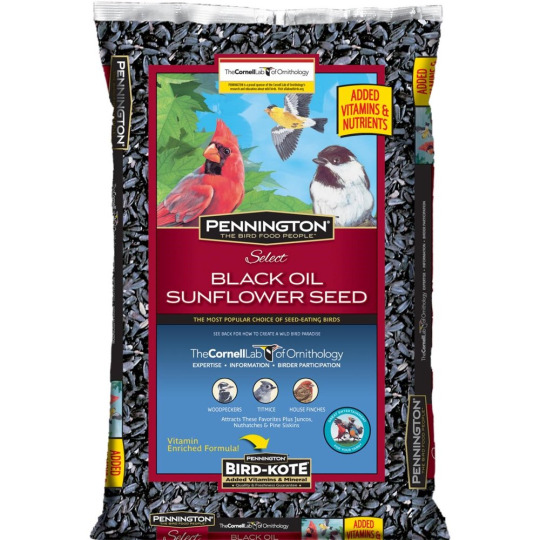
However, beware generic wildflower seed mixes! Many brands like to sell wildflower seed mixes in big box stores like Home Depot, Target, or even Dollar Tree, but they’ll often include flowers that aren’t native or possibly even invasive in your region! Before you make any purchases, double check to make sure the contained seeds won’t do more harm than good! A quality source of native seeds will provide English and Latin names for all seeds included, and will be native to the region or at least non-invasive.

See this? I don't trust this.
There’s a good handful of programs online that’ll send you free seeds if you’re planning to start a native habitat project! Poke around online and see what you can find; you might get lucky! The best time to start looking for these is fall and winter, I find--by early spring, many of them are either done or beginning to wind down... though some also start up in spring. Ultimately--just check regularly! You never know what you can find!
Other Ways to Get Plants
Don’t want to start from seed? That’s fair! You can try cuttings! Just be sure not to take too much of the plant while you do so. Make sure you’ve gotten a few leaf nodes on your cutting, and cut any flowers you may have gotten. Make sure to leave some blooms and foliage on the original plant for the creatures in the current habitat--you don’t want to destroy one habitat to make another in your garden. There’s tons of methods of rooting cuttings, many of which have different efficacy rates for different plants, but that’s a topic for another post.
If you find seedlings growing in a place where they won’t be able to sustain themselves long-term, or are in danger of being destroyed, consider relocating them! You may be able to gently dig up and transplant the seedling to your garden. Don’t do this if they’re in a place where they can easily survive--ideally, you’ll be taking plants from sidewalk cracks, heavily maintained public gardens, roadsides, etc. Do be careful while doing this--ensure your safety first!

You’re totally allowed to join gardening communities like clubs, facebook groups, and more before you’ve even put a trowel to the dirt. These are great places to learn information and advice! Many gardeners are more than happy to help out a new gardener, and will eagerly provide seeds, cuttings, or even baby plants! Talk to some people about your gardening journey and what you’re hoping to do, and you just might find some kindred spirits--or at least get more people interested in the topic!
Seed and plant giveaways and trades happen all the time in gardening clubs, as well as online! Just poke around and see what you can find! Some are explicitly trades, meaning you’re expected to send something in return, but once you get your feet on the ground with some plant knowledge you’ll be stellar! You may be able to explain you’re just starting out, and someone may send you seeds without expecting a trade, but I’d suggest trying giveaways first.

Poke around online and see if there’s a local chapter of your state’s native plant society. From there, you’ll likely be able to find a calendar of events--many of them will host plant sales in the spring, with a bunch of native plant seedlings ripe for the pickings if you can make it out and have some money to spare! Fair warning, though, you’ll want to get there early if you can. If they say they’re starting at 10, try to get there by 9:45. Year after year, there’s always record turnout, and they sell out of plants faster than ever. Just trust me on this. I’ve been let down; hopefully you won’t have to be.
Some libraries are beginning to host seed libraries! Check around and see if your library has one! Ideally, the system works best if you also have seeds to contribute in return, but if you’re just starting out I’m sure they won’t mind you taking some seeds! Just consider saving some seeds to contribute in the future and pay it forward. If your library doesn’t have a seed library? Consider asking if they’d be willing to start one! Community interest is a great way to get the ball rolling on projects like these, but they’ll only know the community is interested if the community tells them they’re interested!
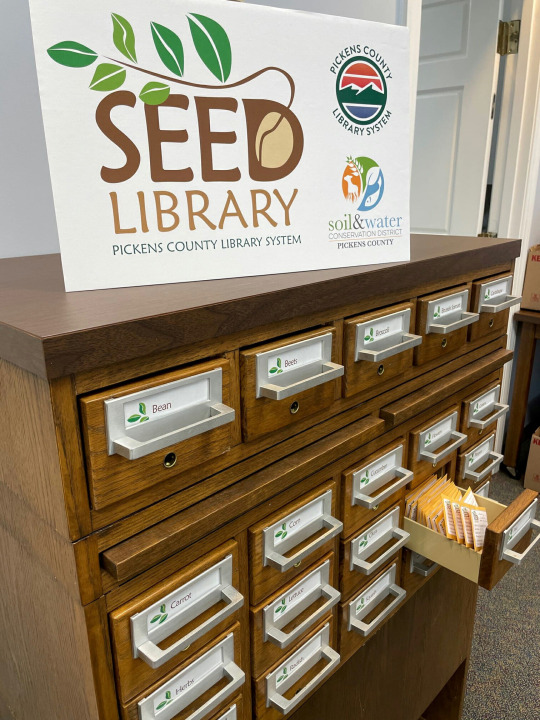
Volunteer to Garden for/with Someone Else
Maybe someone in your area wants to garden, but is struggling to find the time/energy. Many elderly people who used to garden simply can’t anymore but still would like a garden. Other people may love to have a helping hand in their garden. You might even find a few people in your area interested in renting and sharing a community garden plot with others, so they don't have to handle it all on their own! They may be interested in increasing biodiversity right now, or may be willing to if it’s brought up to them. You might be just the kind of person someone needs! Since it won't be your garden, you’ll likely need a bit of permission and collaboration to get anything in particular going, but it’s worth a shot and a way to maybe even make friends!
Again, your mileage may vary with some of these. You may not know where there's a bunch of wildflowers growing in your area, or maybe your local library doesn't have a free seed library. That's okay! Do what you're able to, find what you can find, get what you can get! And there's never any shame with starting small--in fact, starting small can make the project easier to manage and expand when you're able!
That's the end of this post! My next post is gonna be about ways to start growing plants cheaply--low cost seed starting set ups, essentially. There's a lot of good options, many of which I've used myself even! Until then, I hope this advice is helpful! Feel free to reply with any questions, success stories, or anything you think I may have forgotten to add in!
#biodiversity#solarpunk#gardening#outdoor gardening#growing from seed#ani rambles#out of queue#the biodiversity saga#i will be honest I have never flat out approached people to offer to help them garden#HOWEVER. People HAVE approached ME asking ME to help THEM with/plan THEIR garden#granted it was after I'd been gardening for a good few years. and its mostly family or family friends but yknow#people would be like 'oh wanna help me with my veggie garden?' even before I tried growing vegetables#i don't think the library near me has a seed library but you just wait until i. get the courage. to go to the library regularly.#i've seen people also make their own little seed library structures kinda like a little free library but like#i dont think my neighborhood is about that life.#if any of yall have those though it could be a great resource! also send pics because I love seeing them#not to say that this post should become a giant seed trade but if it did become that i would be the opposite of mad#if there's any typos blame my sister shes got the hotel room at like 60-something degrees and I am FREEZING#welp time to shut up now bye
1K notes
·
View notes